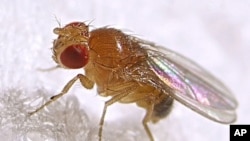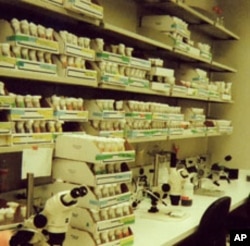At Scripps Research Institute in Jupiter, Florida, scientists are working to find clues about how the human brain processes memories. Their laboratory test animal is not a chimp or a dog or a rat — animals that we know can remember things — it is the common fruit fly.
"They're relatively simple," Ron Davis says, explaining why the fruit fly's brain has some ideal properties for human brain research. "The brain of the fruit fly has about 100,000 neurons. The brain of a human has about 100 billion neurons, and that's an enormous network of interconnected neurons in the human brain, if one thinks about it. We literally can't wrap our brains around the human brain yet."
Fruit fly training regimen
Davis chairs the Department of Neuroscience at Scripps Florida. He's designed an experiment in which fruit flies are trained to remember an odor associated with an unpleasant electrical shock.
It involves a series of Plexiglas tubes which have an electrifiable copper grid on their surfaces. "One puts the fly in these tubes first, passes an odor through the tube," Davis says. "Odor A shocks the animal, mild electric shock." After fresh air has been blown through the tubes to remove any trace of the first odor, a second scent is pumped in.
"Odor B passes through the tube and the animals are not shocked. That's the training where we're hoping the animals will develop an association. They'll learn that one odor is bad because it's been punished in the presence of that odor. And the other odor is okay."
Click to Listen:
Then, the flies are tested to see how well they remember which odor is which. Davis says about 90 percent do, and avoid the electric shock. The ones that don't are isolated, so their genes can be studied.
The human-fruit fly connection
Researchers can remove a fly's brain and place it — still functioning — under a microscope. They can isolate neurons that have different functions and watch them fire -or send signals- to other neurons when stimulated.
Once they identify which neurons are firing differently in the normal flies that have learned to identify the difference, they examine the mutants that don't remember the shocking odor to see how genes control the firing process.
Fruit flies have essentially the same genes as we do, just fewer of them. Davis says that correlation is what makes his research so promising.
"If we find a gene in flies that's important for a process like memory formation, that sequence of that gene is generally conserved [across species]. We can use that gene to identify a similar gene in a mouse or in humans, because they have a very, very high sequence similarity. The bases that make up the gene are very similar." He explains that is how researchers are able to identify with a very high probability in humans the vast majority of genes that exist in fruit flies.
"We're actually quite similar to a fruit fly, believe it or not," he adds with a laugh.
Generations of flies in one room
Fruit flies have a very short lifespan compared to other laboratory animals like the mouse or rat. So, with the flies mating and reproducing every two weeks, many generations of flies can be studied in a year, allowing researchers to do genetic studies quickly. And since the flies are small, hundreds of thousands of them can be stored easily and inexpensively in plastic vials.
Davis shows off a small room at the Institute, filled with vials of fruit flies — all to be used in the search for answers to how our memories are made and stored.
"If one examines the vast majority of neurological diseases — Alzheimer's, Parkinson's and so forth, and psychiatric diseases — schizophrenia, bipolar disorder, ADHD, autism, all of these have a commonality in that they have learning disorders, in general, or memory formation seems to be an underlying feature of the vast majority of neurological and psychiatric diseases."
Davis and his team of researchers hope their work will lead to a drug that will help the brain fight learning- and memory-related diseases. He says gaining a fundamental understanding of how the learning process works could be the key to treating — and perhaps curing — them.















